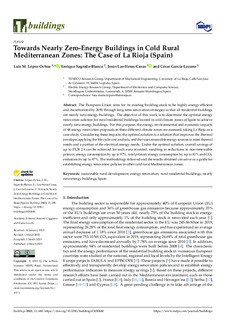Title
Towards Nearly Zero-Energy Buildings in Cold Rural Mediterranean Zones: The Case of La Rioja (Spain)Author
Research Group
Almacenamiento de energíaEconomía Circular y Sostenibilidad Industrial
Sistemas electrónicos de potencia aplicados al control de la energía eléctrica
xmlui.dri2xhtml.METS-1.0.item-contributorOtherinstitution
https://ror.org/0553yr311Version
http://purl.org/coar/version/c_970fb48d4fbd8a85
Rights
© 2023 The AuthorsAccess
http://purl.org/coar/access_right/c_abf2Publisher’s version
https://doi.org/10.3390/buildings13030680Published at
Buildings Vol. 13. N. 3. N. art. 680, 2024Publisher
MDPIKeywords
sustainable rural development
energy renovation
rural residential buildings
nearly zero-energy buildings ... [+]
energy renovation
rural residential buildings
nearly zero-energy buildings ... [+]
sustainable rural development
energy renovation
rural residential buildings
nearly zero-energy buildings
Spain [-]
energy renovation
rural residential buildings
nearly zero-energy buildings
Spain [-]
xmlui.dri2xhtml.METS-1.0.item-unesco-amplio
http://skos.um.es/unesco6/33xmlui.dri2xhtml.METS-1.0.item-unesco-detallado
http://skos.um.es/unesco6/3322Abstract
The European Union aims for its existing building stock to be highly energy-efficient and decarbonized by 2050 through long-term renovation strategies so that all residential buildings are nearly zero ... [+]
The European Union aims for its existing building stock to be highly energy-efficient and decarbonized by 2050 through long-term renovation strategies so that all residential buildings are nearly zero-energy buildings. The objective of this work is to determine the optimal energy renovation solution for rural residential buildings located in cold climate zones of Spain to achieve nearly zero-energy buildings. For this purpose, the energy, environmental and economic impacts of 48 energy renovation proposals in three different climate zones are assessed, taking La Rioja as a case study. Considering these impacts, the optimal solution is a solution that improves the thermal envelope, applying the life cycle cost analysis, and that uses renewable energy sources to meet thermal needs and a portion of the electrical energy needs. Under the optimal solution, overall savings of up to EUR 2.4 can be achieved for each euro invested, resulting in reductions in non-renewable primary energy consumption by up to 97%, total primary energy consumption by up to 81% and CO2 emissions by up to 97%. The methodology followed and the results obtained can serve as a guide for establishing energy renovation policies in other cold rural Mediterranean zones. [-]
Collections
- Articles - Engineering [688]
The following license files are associated with this item:























